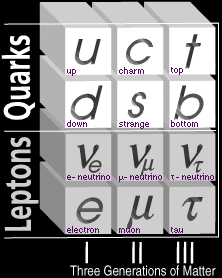 The Standard Model is Not Enough
The Standard Model is Not Enough




While the Standard Model
provides a very good description of
phenomena observed by experiments, it is still an incomplete theory.
The problem is that the Standard Model can't explain
why some particles exist as they do. For example, even though
physicists knew the masses of all the quarks except for top quark for many
years, they were simply unable to accurately predict top's mass without
experimental evidence because the Standard Model lacks a mathematical
model for finding a pattern for particle masses.
 Another question concerns the fact that there are
3 pairs of quarks and 3 pairs
of leptons. Each "set" of these particles is called a
generation (a.k.a. family).
Therefore, the up/down
quarks are first generation quarks, while the electron
and e- neutrino are first generation leptons.
Another question concerns the fact that there are
3 pairs of quarks and 3 pairs
of leptons. Each "set" of these particles is called a
generation (a.k.a. family).
Therefore, the up/down
quarks are first generation quarks, while the electron
and e- neutrino are first generation leptons.
In the every-day world we observe only the first-generation particles
(electrons, e- neutrinos, and up/down quarks). Why does the natural world
"need" the two other generations?
We thank Fermi National Laboratory for use of part of their image.


 Another question concerns the fact that there are
3 pairs of quarks and 3 pairs
of leptons. Each "set" of these particles is called a
generation (a.k.a. family).
Therefore, the up/down
quarks are first generation quarks, while the electron
and e- neutrino are first generation leptons.
Another question concerns the fact that there are
3 pairs of quarks and 3 pairs
of leptons. Each "set" of these particles is called a
generation (a.k.a. family).
Therefore, the up/down
quarks are first generation quarks, while the electron
and e- neutrino are first generation leptons.